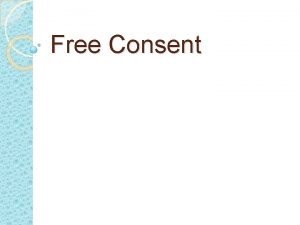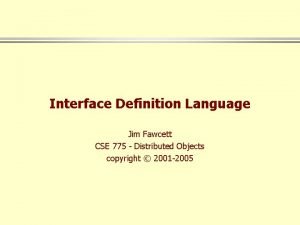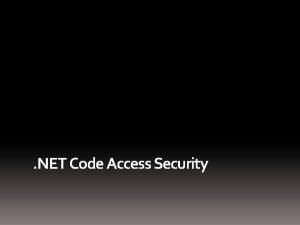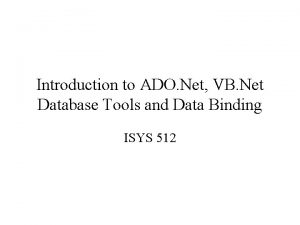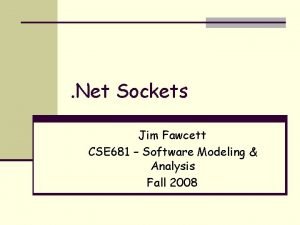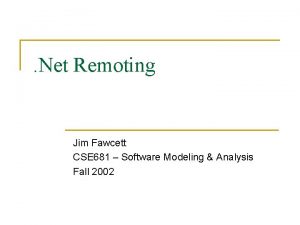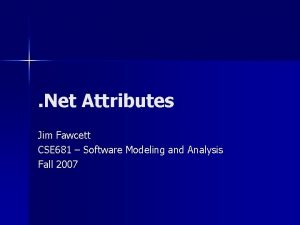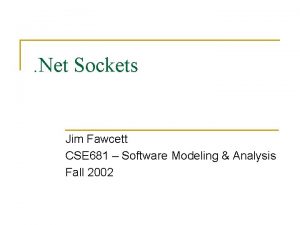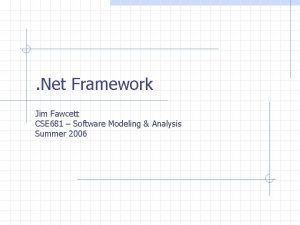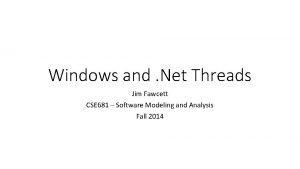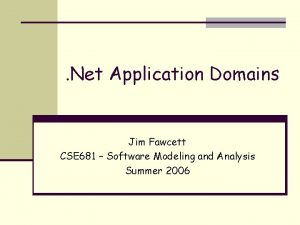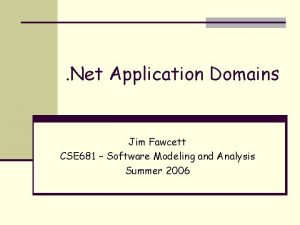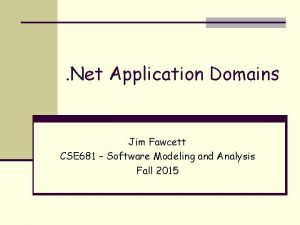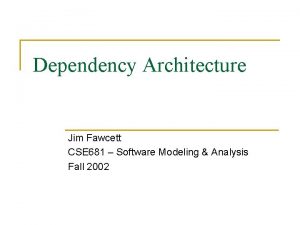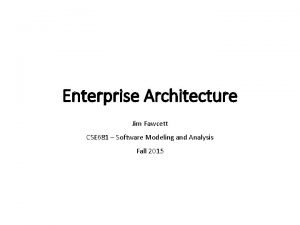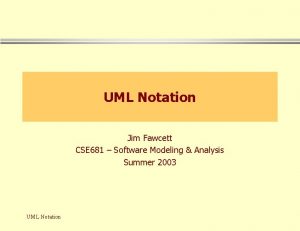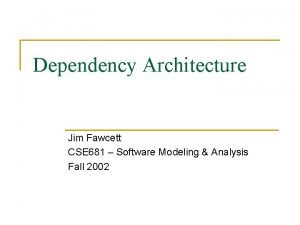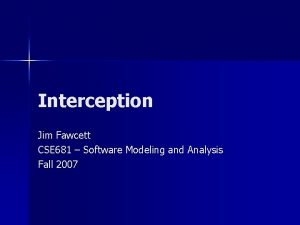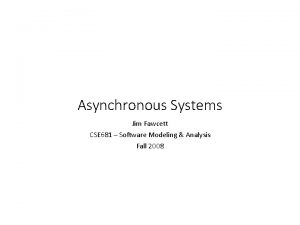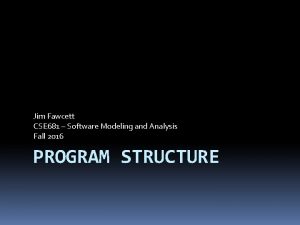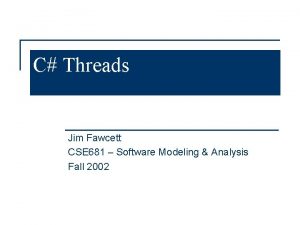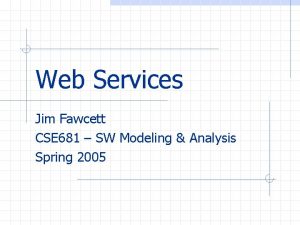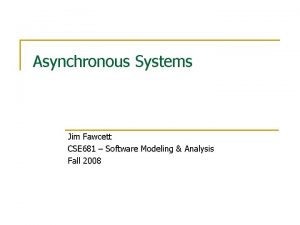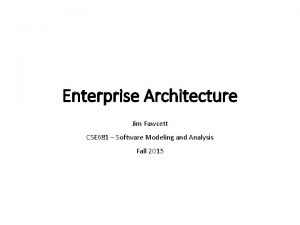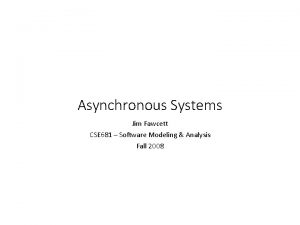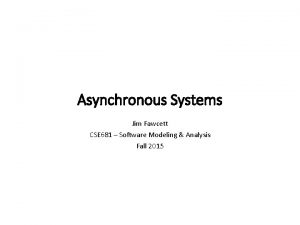Net Security Jim Fawcett CSE 681 SW Modeling
































- Slides: 32

. Net Security Jim Fawcett CSE 681 – SW Modeling & Analysis Summer 2008

References n n n Developmentor Slides from MSDNAA, Keith Brown Introduction to Evidence-based Security in. Net Framework, Brad Merrill, http: //www. dcl. hpi. unipotsdam. de/LV/Components 04/VL 7/05 a_Securitydetailed. pdf Securing, Deploying and Maintaining. Net Applications, Patrick Tisseghem, www. u 2 u. net

Agenda n n n Threats Windows Role-Based Security Code Access Security

Basic Security Issues n Confidentiality n n Integrity n n Identify a user securely Authorization n n Decide who has access to information and how to make access effective Authentication n n Ensure that data is not modified without authorization Availability n n Disclose information only to authorized users Define a set of allowed actions for authorized users Non repudiation n Log users, their actions, and the objects used.

Security Models n Windows and. Net n Role-based § Authenticate and authorize users, groups, and accounts (System, Local service, Network service) § Actions are authorized through permissions n Evidence-based or Code Access Security (CAS) § Code is elevated to the security status of a user. § Authorization is based on evidence • url, zone, publisher, strong name, custom assembly attributes § Actions are authorized through policies

Win Security Definitions n Definitions for people and groups of people n SID – Security IDentifier § Data structure used to identify user or group. n Access Token § A data structure that holds a SID for a security principal, the SIDs for each group the principal belongs to, and a list of the principal’s priviledges on the local computer. n Principal § An account holder that is assigned a SID for access to resources, e. g. , user, group, service, or computer.

Win Security Definitions n Definitions for objects n n Files, directories, kernel objects ACL – Access Control List § Set of permissions for a specific object or a set of the object’s properties. § Discretionary (DACL) and System (SACL) are subgroups. n Security Descriptor § A data structure holding information about a protected object, e. g. , who can access, in what way, whether audited.

Win Security Definitions n Combinations of people and objects n Security Context § Set of rules for a user’s actions on a protected object § Combination of user’s access token and object’s security descriptor n Security Policy § Rules that define the allowable contexts and mandatory groups.

Role-Based Security n n Use role-based security in programs to control access to methods or properties at run-time. Host authenticates user and provides identity and role information to CLR. n n n Uses NTFS access control lists, IIS security settings. CLR makes that information available to code via APIs and permission demands. Can isolate security from code using attributes defined in System. Security or Enterprise. Services n n System. Security is limited to Windows user groups Enterprise. Services uses COM+ roles § Classes have to inherit from Enterprise. Services n Which to choose? n n If application has both managed and unmanaged use COM+. If application is entirely managed then System. Security is appropriate.

Code Access Security n Goals n End-user experience § Managed apps just run § Safe defaults, no run-time decisions needed n Administrator § § § All settings in one place and easy to customize Simple policy model Security administration tools • . Net configuration, CASPOL n Developer § Focus on application, security comes free § Easy to understand extend when needed

Mobil Code n Old Model n n n n Obtained from a network, often via a web page. Without CAS have either full trust or no trust. User decides whether to run. If run, code has all the user’s priviledges. Inproc COM component, when loaded, becomes part of the process. Can’t distinguish between library code and original application code. CAS model n n n Operation based on evidence. Allowed actions can be defined at very detailed level. Each assembly can have its own security context.

Evidence-Based Security n Definitions n Permissions § Objects that represent specific authorized actions § Permission grant is an authorization for an action given to an assembly § Permission demand is a security check for specific grants n Policy § Set of permissions granted to an assembly n Evidence § Inputs to policy about code n All three can be extended using security APIs.

Standard Permissions n Permissions for framework resources n n n Data, environment, file IO, Message Queue, reflection, sockets Directory services, event log, web, performance counters, registry, UI DNS, file dialog, isolated storage, printing, security system

Standard Permissions n Identity permissions n n Publisher, site, string name, url, zone User identity permission n Only non-code access permission in Framework.

Code Access Security n n Is evidence-based Most permissions are code access n n Demanding permission performs a stack walk checking for grants of all callers Two ways to make checks § Imperative – call a method § Declarative • Attributes in code • Attributes in configuration file n Get security by § Calling class libraries in Framework § Calling application code with checks

How it works n n Loader extracts evidence from assembly Evidence is input to policy n Each level, Enterprise, Machine, User, and App. Domain, are evaluated § For each level the union of grants for each matching code group is determined § Intersection of permissions from each of these levels are granted to the assembly n n Apply any assembly permission requests Result is the permissions granted to the assembly.

Stack Walk Modifiers n Assertions n n If code vouches for its callers then checks for permissions stop here. Gatekeeper classes n Managed wrappers for unmanaged resources § Demand permission to call unmanaged § Assert permission to call unmanaged § Make the call to unmanaged

Code Access Control n Identity permissions can apply to code as well as users and groups n n n Based on evidence – signature, location, … Declarative checks made by JIT at compiletime. Imperative checks made by CLR at run-time.

Policy n Process of determining what permissions to grant to code. n n Policy levels n n n Enterprise Machine User Application domain Each policy level is a collection of code groups n n Per-assembly basis All code, internet zone, intranet zone, site, strong name (MS Office), publisher Permission grants are intersection of policy levels and union of collection of code groups. n n Code gets only permissions common to Enterprise, Machine, user, App. Domain Gets all permissions of all groups to which it belongs.

Default Policies n Local Computer n n Intranet n n Safe UI, isolated storage, web access to same site Restricted n n Limited read environment, UI, isolated storage, assertion, web access to same site, file read to same UNC directory Internet n n Unrestricted No access, can’t execute Strong name (Framework classes) n Unrestricted

Framework Support n Classes used to represent evidence n n Zone, Url, Site, Application. Directory, Strong. Name, Publisher, Hash Classes used to represent permissions n DBData. Permission, Printing. Permission, Socket. Permission, File. IOPermission, Registry. Permission, …

. Net Configuration Tool

Editing Permissions

All Standard Permissions Can configure applications as well as users and machines.

Creating a User Code Group

Adding New Permissions

Specific Permissions

The Result

Evidence n Evidence is input to policy n n Evidence is extensible n n n Any object can become evidence Only affects permission grants if some code group condition uses it Hosts n n Strong name, publisher identity, location Machine, IIS, ASP. Net, SQL Server Fully trusted hosts specify implicitly trusted evidence. Semi-trusted hosts cannot provide evidence. Hosts can limit policy for App. Domains they create.

Requesting Permissions n Assemblies can request permissions n n Minimal, Optional, Refused If policy does not grant everything in Minimal set, assembly will not load. Assembly is granted: Max. Allowed (Minimal Optional) – Refused Example: [assembly: UIPermission. Attribute (Security. Action. Request. Minimum, Window=UIPermission. Window. Safe. Sub. Windows) ] [assembly: Security. Permission. Attribute (Security. Action. Request. Refused, Unmanaged. Code=true) ]

Minimizing Security Flaws n Safe code n n Managed code verified for typesafety at runtime. Eliminates: § § n n Buffer overrun attacks Reading private state or uninitialized memory Access to arbitrary memory in process Transfer execution to arbitrary location in process Developers can use Least Priviledge. Code access security blocks most luring attacks. n Stack walks prevent malicious code from using otherwise secure code obtained from naïve user.

Summary n Managed code has both Role-based and Evidence-based (CAS) security applied. n n n Get a lot for free, simply by loggin in and running code that calls Framework Library. You can add security features to your code as well. CAS is. Net model for mobile code. Evidence is discovered by loader Policy turns evidence into permissions Permissions determine what your code can and cannot do.
 681 complex inc
681 complex inc 681 complex inc
681 complex inc Cs 681
Cs 681 Round 246 to the nearest hundred
Round 246 to the nearest hundred Helen erickson nursing theory
Helen erickson nursing theory Relational vs dimensional data modeling
Relational vs dimensional data modeling Security private
Security private Brian fawcett
Brian fawcett Contract without free consent
Contract without free consent Brian fawcett
Brian fawcett Hamilton was born where
Hamilton was born where Philippa fawcett
Philippa fawcett Barry fawcett
Barry fawcett Dennis fawcett
Dennis fawcett Dr richard fawcett
Dr richard fawcett Graham fawcett
Graham fawcett Fawcett definition
Fawcett definition Barry fawcett
Barry fawcett Jonathan ruby
Jonathan ruby Jim quinn net worth
Jim quinn net worth Osi security architecture
Osi security architecture Guide to network security
Guide to network security Wireless security in cryptography
Wireless security in cryptography Visa international security model in information security
Visa international security model in information security Electronic mail security in network security
Electronic mail security in network security What is nstissc security model
What is nstissc security model Security policy and integrated security in e-commerce
Security policy and integrated security in e-commerce Software security building security in
Software security building security in Security guide to network security fundamentals
Security guide to network security fundamentals Security guide to network security fundamentals
Security guide to network security fundamentals Code access security
Code access security Achmed lach net ich krieg mein tach net
Achmed lach net ich krieg mein tach net Ado.net vb.net
Ado.net vb.net








